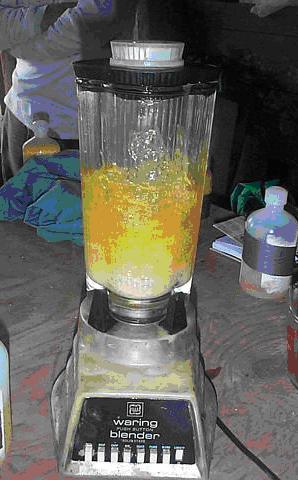|
SYNTHESIS
Transesterification is the process of making biodiesel from vegetable
oil. It is the transformation of one type of an ester, a hydrocarbon
chain, into another type. A vegetable oil molecule is made up of
three esters attached to a molecule of glycerin. The scientific
name of vegetable oil is triglyceride. About 20% of vegetable oil
molecule is glycerin. It’s the part that makes the oil thick
and sticky. During transesterification, glycerin is removed to make
the oil thinner, reducing viscosity.
To make biodiesel, the esters in the vegetable oil are separated
from the glycerin. The glycerin is replaced with an alcohol like
ethanol or methanol. Methanol is preferred because it produces a
more stable reaction. Each of the three esters attaches to an alcohol
creating three alkyl ester molecules.
A catalyst is required to break the triglyceride molecule. Either
sodium hydroxide, also known as lye, or potassium hydroxide can
be used as a catalyst. After the esters are free, the catalyst will
combine with the glycerin, which settles at the bottom of the container,
eventually creating a soap. The amount of catalyst used in this
reaction depends of the pH of the vegetable oil, which is acidic
and sometimes called a fatty acid.
Used vegetable oil is more acidic than new vegetable oil because
it has been heated or fried, becoming hydrogenated if in the presence
of hydrogen. Free fatty acids can be created when frying oil and
will attach to bases, so it is important to eliminate them by adding
more catalyst.
STEP BY STEP
In a biodiesel reaction, methanol makes up 20% of the volume, which
would be 200 milliliters per liter of vegetable oil. Lye makes up
0.35%, which is 3.5 grams per liter of vegetable oil if the oil
it new. If the vegetable oil is not new, the amount of catalyst
(lye) may vary and a titration must be performed to know the exact
amount.
Add one gram of lye to one liter of distilled water, creating a
lye/water solution, and set aside. Dissolve one milliliter of used
vegetable oil into 10 ml of isopropyl alcohol (rubbing alcohol).
Use an eyedropper to add 1 ml of the lye/water solution to the oil/alcohol
solution. Check the pH of this new mixture with litmus paper. The
pH needs to be between 8 and 9. Continue adding milliliters of lye/water,
counting how many is added, until the correct pH is met. (Usually
no more than 3 milliliters will be added) Use the following equation
to determine how many grams of lye to add per liter of vegetable
oil. (x + 3.5) = L. Where x = the number of milliliters of lye added
to oil mixture and L = the number of grams of lye per liter of vegetable
oil. Usually L is around 4.5 to 6.5.
 |
Measure out all the ingredients before starting the mixture.
To start, have 1 liter of vegetable oil, 200 ml of methanol
and 3.5 grams (or L) of lye on hand. Be sure to use a properly
working blender for mixing. Carefully pour the methanol into
the blender, followed by the lye. Cover the blender and blend
on the lowest setting for 30 seconds or until the lye is dissolved.
This solution is called sodium methoxide. Carefully add the
vegetable oil to the sodium methoxide. Once the top is secured,
blend on medium or high for 15 minutes. Watch for the blender
getting too hot.
Allow the glycerin to settle, which usually takes 8 hours.
After the glycerin is fully settled, the biodiesel must be
drained off. It is best to use a small electric pump or hand
pump, but if you must, a ladle can be used to scoop the biodiesel
out. Also a stopcock works well because it can drain the glycerin
out. |
If you expose the glycerin to air and sunlight for 1 week, it can
then be used as soap. Be sure not to reuse the blender for food,
and store excess ingredients in a cool, dry place.
Water wash:
A water wash is generally unnecessary because 99.9% of the catalyst
and glycerin have settled at the bottom and were removed. The advantage
of no water wash would be any un-reacted alcohol left in the biodiesel.
The alcohol acts as a fuel additive by increasing the energy in
the biodiesel. The disadvantage, however, is if the vehicle has
rubber fuel hoses. The excess alcohol increases wear on these hoses
as well as decreasing the flash point of biodiesel. If the biodiesel
contains more than 0.2% alcohol, it does not meet ASTM standards.
If a wash is to be performed, slowly sprinkle water into the biodiesel
(after the glycerin has been removed) until there is an equal amount
of water vs. biodiesel. Gently mix the water and biodiesel for 5
minutes, which will form a white, milky mixture. Allow the water
to settle and separate from the biodiesel, which usually takes several
days. Once settled, the biodiesel will be floating on top of the
water. Drain the water out and check the pH of the biodiesel. It
should be around 7. Although unnecessary, biodiesel can be washed
up to 3 times.
Testing:
First do a visual inspection on the biodiesel. A successful mixture
results in two distinct layers. The top layer will be lighter in
color than the bottom. If the solution has a milky layer, it is
the result of too much catalyst being used and should be washed
with water. If it was unsuccessful, the mixture will appear as a
homogenous gel or soap.
The specific gravity of the biodiesel can be tested. It determines
how dense the fuel is. According to the 1999 ASTM standards for
biodiesel, biodiesel should have a specific gravity of no more than
0.900 at 60ºF and a Kinematic viscosity of no more than 6 at
104 ºF. A hydrometer is used to measure the specific gravity.
|

